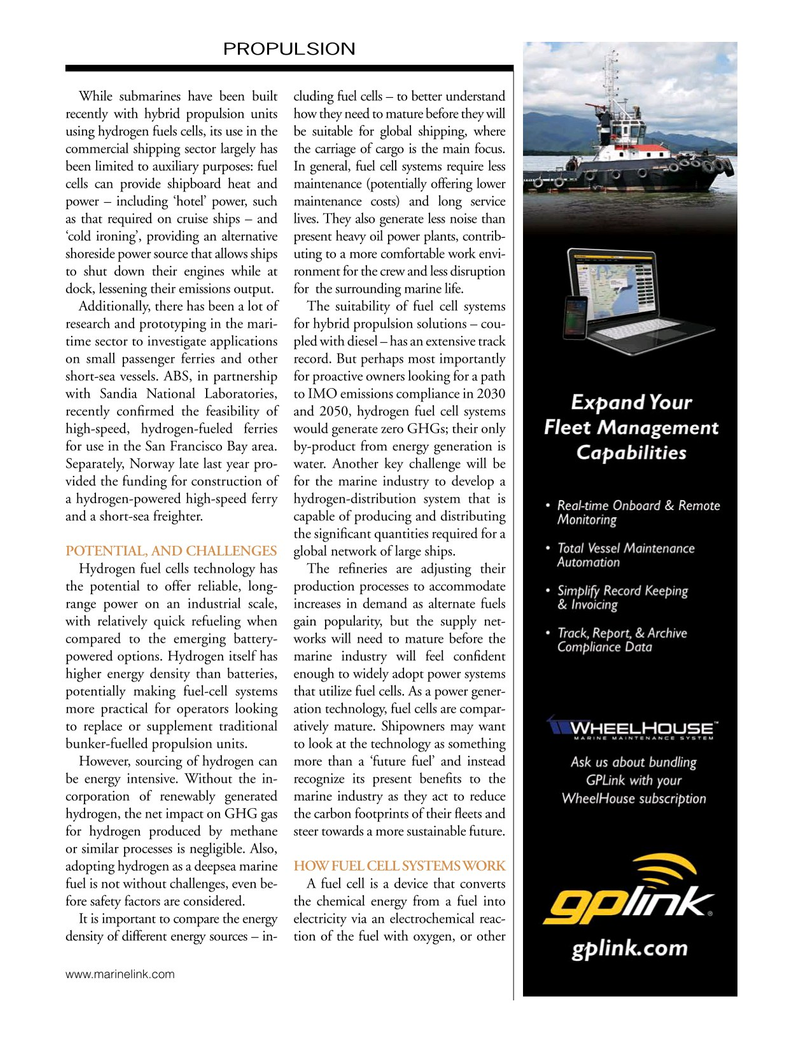
Page 29: of Marine News Magazine (March 2019)
Pushboats, Tugs & Assist Vessels
Read this page in Pdf, Flash or Html5 edition of March 2019 Marine News Magazine
PROPULSION
While submarines have been built cluding fuel cells – to better understand recently with hybrid propulsion units how they need to mature before they will using hydrogen fuels cells, its use in the be suitable for global shipping, where commercial shipping sector largely has the carriage of cargo is the main focus. been limited to auxiliary purposes: fuel In general, fuel cell systems require less cells can provide shipboard heat and maintenance (potentially offering lower power – including ‘hotel’ power, such maintenance costs) and long service as that required on cruise ships – and lives. They also generate less noise than ‘cold ironing’, providing an alternative present heavy oil power plants, contrib- shoreside power source that allows ships uting to a more comfortable work envi- to shut down their engines while at ronment for the crew and less disruption dock, lessening their emissions output. for the surrounding marine life.
Additionally, there has been a lot of The suitability of fuel cell systems research and prototyping in the mari- for hybrid propulsion solutions – cou- time sector to investigate applications pled with diesel – has an extensive track on small passenger ferries and other record. But perhaps most importantly short-sea vessels. ABS, in partnership for proactive owners looking for a path with Sandia National Laboratories, to IMO emissions compliance in 2030 recently confrmed the feasibility of and 2050, hydrogen fuel cell systems high-speed, hydrogen-fueled ferries would generate zero GHGs; their only for use in the San Francisco Bay area. by-product from energy generation is
Separately, Norway late last year pro- water. Another key challenge will be vided the funding for construction of for the marine industry to develop a a hydrogen-powered high-speed ferry hydrogen-distribution system that is and a short-sea freighter. capable of producing and distributing the signifcant quantities required for a poTenTiAl, AnD ChAllenges global network of large ships.
Hydrogen fuel cells technology has The refneries are adjusting their the potential to offer reliable, long- production processes to accommodate range power on an industrial scale, increases in demand as alternate fuels with relatively quick refueling when gain popularity, but the supply net- compared to the emerging battery- works will need to mature before the powered options. Hydrogen itself has marine industry will feel confdent higher energy density than batteries, enough to widely adopt power systems potentially making fuel-cell systems that utilize fuel cells. As a power gener- more practical for operators looking ation technology, fuel cells are compar- to replace or supplement traditional atively mature. Shipowners may want bunker-fuelled propulsion units. to look at the technology as something
However, sourcing of hydrogen can more than a ‘future fuel’ and instead be energy intensive. Without the in- recognize its present benefts to the corporation of renewably generated marine industry as they act to reduce hydrogen, the net impact on GHG gas the carbon footprints of their feets and for hydrogen produced by methane steer towards a more sustainable future.
or similar processes is negligible. Also, adopting hydrogen as a deepsea marine how Fuel Cell sysTems work fuel is not without challenges, even be- A fuel cell is a device that converts fore safety factors are considered. the chemical energy from a fuel into
It is important to compare the energy electricity via an electrochemical reac- density of different energy sources – in- tion of the fuel with oxygen, or other www.marinelink.com

 28
28

 30
30
